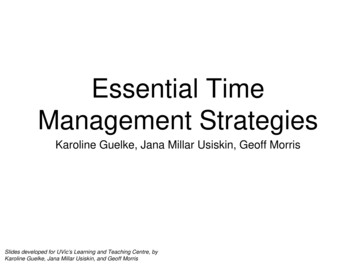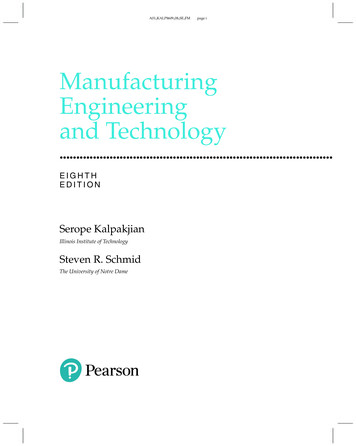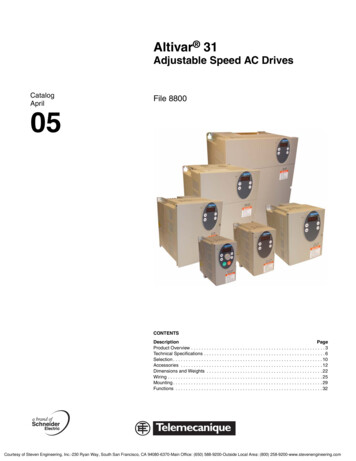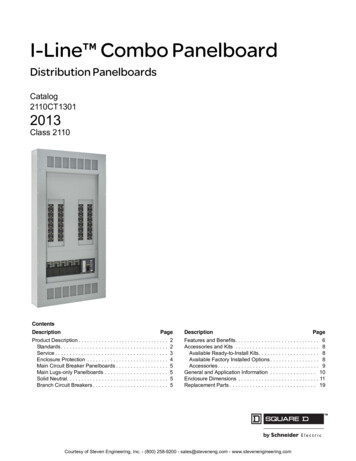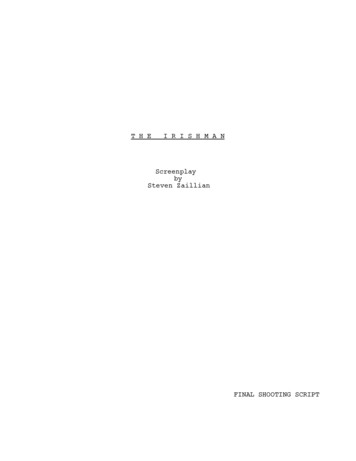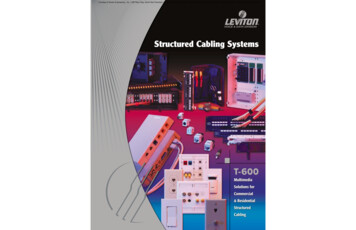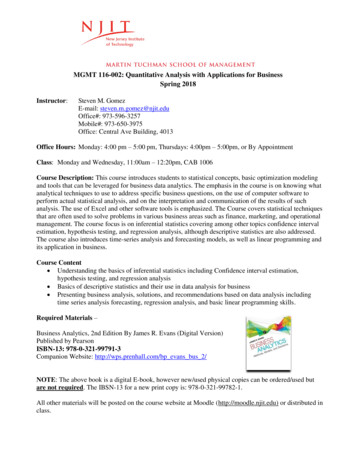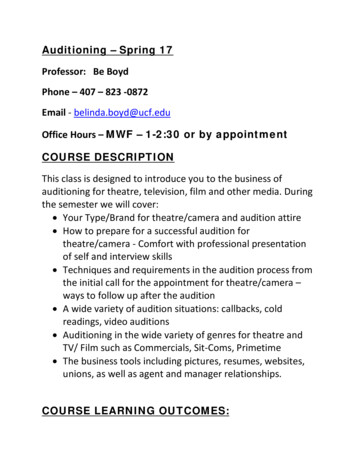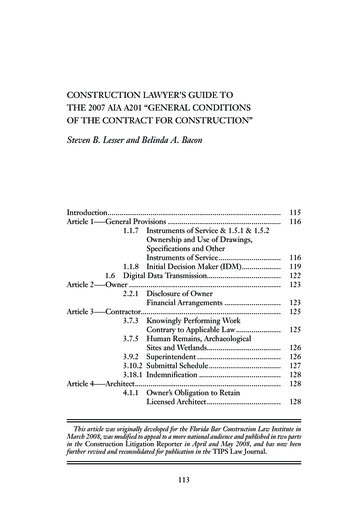
Transcription
CONSTRUCTION LAWYER’S GUIDE TOTHE 2007 AIA A201 “GENERAL CONDITIONSOF THE CONTRACT FOR CONSTRUCTION”Steven B. Lesser and Belinda A. BaconIntroduction .Article 1—–General Provisions .1.1.7 Instruments of Service & 1.5.1 & 1.5.2Ownership and Use of Drawings,Specifications and OtherInstruments of Service .1.1.8 Initial Decision Maker (IDM) .1.6 Digital Data Transmission.Article 2—–Owner .2.2.1 Disclosure of OwnerFinancial Arrangements .Article 3—–Contractor.3.7.3 Knowingly Performing WorkContrary to Applicable Law .3.7.5 Human Remains, ArchaeologicalSites and Wetlands.3.9.2 Superintendent .3.10.2 Submittal Schedule .3.18.1 Indemnification .Article 4—–Architect.4.1.1 Owner’s Obligation to RetainLicensed Architect .115116116119122123123125125126126127128128128This article was originally developed for the Florida Bar Construction Law Institute inMarch 2008, was modified to appeal to a more national audience and published in two partsin the Construction Litigation Reporter in April and May 2008, and has now beenfurther revised and reconsolidated for publication in the TIPS Law Journal.113
114 Tort Trial & Insurance Practice Law Journal, Summer-Fall 2008 (43:4/44:1)4.2.1Duration of Contract AdministrationServices .4.2.2 Site Visits .4.2.3 Architect’s Reporting Obligation .4.2.8 Contractor Requests forEquitable Adjustments.4.2.11 Architect as Interpreter .4.2.14 Requests for Information .Other LEED / Green BuildingConsiderations .Article 5—–Subcontractors .5.4.1 & 5.4.3 Contingent Assignmentof Subcontracts .Article 8—–Time .8.2 Progress and Completion .Article 9—–Payments and Completion .9.2 Schedule of Values .9.5 Decisions to Withhold Certification .9.5.3 Joint Checks .9.6 Progress Payments.9.6.4 Owner’s Right to ContactSubcontractors RegardingProper Payment .9.10 Final Completion and Final Payment .Article 10—Protection of Persons and Property .10.3 Hazardous Materials.Article 11—Insurance and Bonds.11.1 Contractor’s Liability Insurance.11.1.4 Additional Insureds.Article 13—Miscellaneous Provisions.13.1 Governing Law .13.7 Time Limit on Claims .Article 14—Termination or Suspension of the Contract .14.2.2 Termination by the Ownerfor Cause .Article 15—Claims and Disputes .15.1.1 Definition of Claims .15.1.2 Notice of Claim .15.2 Initial Decision .15.2.1 Claims Decided by the InitialDecision Maker .15.2.2–15.2.5The IDM’s Initial Decision .15.2.6 & 15.2.6.1 Demand for 143144144145146
Construction Lawyer’s Guide to the 2007 AIA A20115.3.1–15.3.3 Mediation .15.4.1–15.4.6 Arbitration .15.4.4 Consolidation or Joinder .Conclusion .115146147148149introductionOn November 5, 2007, the American Institute of Architects (AIA) issued its2007 version of A201 General Conditions of the Contract for Construction (A2012007).1 A201 has been the most widely used document in the AIA family ofcontract documents dating back to 1911. This latest revision cycle introduces both significant and subtle changes that impact the rights and responsibilities of owners, contractors, design professionals, and subcontractors.2AIA revises its documents every ten years to keep pace with a fast-moving,ever-changing industry while balancing the interests of participating parties.3Earlier versions of A201 offered little assistance to construction participantslooking to make sense of various provisions, including the dispute-resolutionprocess, mutual waiver of consequential damages, insurance, and the rightof the contractor to obtain financial assurances from the owner duringconstruction.AIA solicited feedback from industry representatives such as the Associated General Contractors of America, the American College of Construction Lawyers, the American Bar Association Forum on the ConstructionIndustry (ABA Forum), and others to address a wide range of concerns withthis latest version.4 Notwithstanding these efforts, A201 2007 has quicklybecome a focal point of controversy and criticism. Indeed, after fifty yearsof endorsing A201, the Associated General Contractors of America recently declined to do so.51. All references to “AIA A201” relate to AIA Document A201 -2007, published by AIA.2. This article will also refer to other 2007 AIA documents. The 1997 version of the agreement between the owner and architect designated as the two-part B141 has now been revamped as a single document designated as B101, with a more detailed version for use onlarge-scale projects designated as B103. The 2007 revisions include the creation or modification of nearly forty contract documents. See 14 AIArchitect (Nov. 2, 2007).3. Industry comments were solicited from more than a dozen owner, engineer, attorney, and contractor groups. See Suzanne Harness, Overview to Charles M. Sink, A. HoltGwyn, James Duffy O’Connor & Dean B. Thomson, The 2007 A201 Deskbook 2 (ABA2008).4. The coauthor of this paper, Steven B. Lesser, in his capacity as chair of the Division12, Owners and Lenders Steering Committee of the ABA Forum, met with the A201 AIADocuments Committee along with Division 12 members Stanley J. Dobrowski of Columbus,Ohio, and Christopher S. Dunn and L. Wearen Hughes of Nashville, Tennessee, to providethe perspective of owners and lenders relative to proposed changes to AIA A201.5. In a letter dated October 9, 2007, the Associated General Contractors of America declined to endorse the use of AIA A201 2007. See Associated General Contractors of America,
116 Tort Trial & Insurance Practice Law Journal, Summer-Fall 2008 (43:4/44:1)This paper will address many new controversial issues in AIA A201 2007,including the shift to litigation serving as the default mechanism to resolvedisputes as opposed to arbitration, the role of a new participant, the “initialdecision maker,” insurance provisions, hazardous waste, and the ten-yearstatute of repose.6Throughout this paper, a “Practice Tip” section is included to providethe construction practitioner with some practical drafting suggestions andadvice.article 1—general provisions1.1.7 Instruments of Service & 1.5.1 & 1.5.2 Ownership and Use ofDrawings, Specifications and Other Instruments of ServiceThis new provision eliminates the “project manual.” Instead, “instrumentsof service” now include “. . . without limitation, studies, surveys, models,sketches, drawings, specifications, and other similar materials.”7 Deletion ofthe project manual coupled with this sweeping definition of instrumentsof service suggests that the conventional dog-eared project manual repletewith forms, specifications, and other hard-copy design documents has become obsolete.8Overall, the 2007 AIA documents acknowledge an industry trend moving toward achieving a paperless exchange of data among various participants in the design and construction process.9 As building informationAGC Members Unanimously Vote Against A201 Endorsement, Constr. News (Oct. 12, 2007), atwww.agc.org/cs/news media/press room/press release?pressrelease.id 72.6. This paper is not intended to include an exhaustive discussion of all changes. Only themost controversial changes will be addressed. For a complete table-style listing with AIA’scomments on every change, see AIA Document A201 –2007 Commentary 2007, a free paper available at www.aia.org/SiteObjects/files/Condocs A201Comm.pdf; see also Sink et al.,supra note 3. Various controversial holdover provisions from 1997 remain, such as the mutualwaiver of consequential damages, and will not be discussed. For a thorough discussion ofholdover provisions from A201 1997, see Mark J. Heley, John Markert, Shannon J. Briglia &Daniel J. Wierzba, Lessons Learned: How the 1997 Revisions to A201 Have Fared After 10 Years.Litigation Experience and Negotiation Tips, in The 2007 AIA Documents: New Forms, NewIssues, New Strategies (ABA 2008) (distributed at ABA Forum Midwinter Meeting, Jan.2008).7. A201 § 1.1.7 (2007).8. James Duffy O’Connor, The Demise of the Project Manual; Early Bird Financial Disclosures:Hazardous Haz-Mat Revisions & Insuring the Uninsurable, in The 2007 AIA Documents: NewForms, New Issues, New Strategies (ABA 2008) (distributed at ABA Forum MidwinterMeeting, Jan. 2008). It is important for the practitioner to avoid reviewing these changes ina vacuum. Although the project manual reference is deleted in A201, § 3.4.3 of B101 2007requires the architect to “compile a project manual that includes the Conditions of the Contract for Construction and Specifications and may include bidding requirements and sampleforms.”9. Id.
Construction Lawyer’s Guide to the 2007 AIA A201117modeling (BIM)10 is introduced to the construction industry, assortedprovisions of A201 and other AIA documents, including the Digital DataLicensing Agreement,11 further evidence the popularity of this approach.Now that digital sharing of information has become commonplace, participants must confront issues associated with copyright ownership asthey assess liability for contributing design details that may ultimatelyresult in a building defect. Owners and contractors agree that copyrightprotection over instruments of service in both tangible and intangibleform provides design professionals with powerful leverage over a construction project.12In A201 2007, new §§ 1.5.1 and 1.5.2, under the paragraph 1.5 headingof “Ownership and Use of Drawings, Specifications and Other Instruments of Service,” were created to replace the former § 1.6.1 of A2011997. Section 1.5.1 covers copyright ownership, and § 1.5.2 covers usagerights and restrictions. These provisions need to be read in conjunction(and coordination) with AIA’s owner/architect agreements, which set outthe respective rights of those two parties. Prior versions of AIA documents revoked license agreements if an owner terminated the architectfor any reason.13 B141 1997 required all documents be returned to thearchitect in the wake of termination.14 Use of a project’s instruments ofservice could be reinstated but only after the architect was adjudged liablefor a breach, which might occur many years later.15 Without use of thesedocuments, construction would be brought to a sudden halt, exposing theproject’s owner to delay damages claims from the contractor. Although an10. See Benton T. Wheatley & Travis W. Brown, An Introduction to Building InformationModeling, 27 Constr. Law. 33 (Fall 2007); Preparing for Building Information Modeling, AIAPrac. Mgmt. Dig. (Summer 2007).11. Digital Data Licensing Agreement, AIA C106 (2007); Digital Data Protocol ExhibitE201 (2007).12. Section 1.1.7 does not limit the definition of instruments of service to tangible materials.The Associated General Contractors of America recognize that the digital transfer of data isat the forefront of today’s project delivery approaches to integrated design and construction.See Charles M. Sink, Mark D. Petersen & Howard Goldberg, Lessons Learned: The Evolutionof AIA Document A201 from 1963 to 2006, and a Look into the Future, in Lessons Learned:Benefiting Your Project from Others’ Experiences—Good and Bad (Apr. 2007) (distributed at ABA Forum Annual Meeting, Carolina, Puerto Rico). Other industry groups havecontemplated the use of digital data as found in the EJCDC C-700 Standard General Conditions § 3.6 (2007) (only hard copy may be relied upon; conclusions or information derivedfrom electronic files at user’s risk) and Guideline on Exchanging Documents and Data in ElectronicForm (AGC 2005), as well as the recently published ConsensusDOCS 200.2 The ElectronicCommunications Protocol Addendum (2007) (accuracy of data conveyed electronically is responsibility of transmitting party).13. B141 § 1.3.2.2 (1997).14. Id. B101 2007 and B103 2007 do not require the owner to return the documents tothe architect.15. Id.
118 Tort Trial & Insurance Practice Law Journal, Summer-Fall 2008 (43:4/44:1)improvement to earlier versions, B101 2007 still allows the architect toterminate the nonexclusive license because of nonpayment.16One new feature of B101 2007 provides greater flexibility to use instruments of service without participation of the architect.17 However, inthat scenario, the owner must release, indemnify, and hold harmless thearchitect and its consultants for any damages resulting or arising from theowner’s continued use.18 A fair reading of this provision also suggests thatthe original architect and its consultants would be released from any liability for defects or errors and omissions in the plans should they be usedto complete the project without participation of the architect.19 Note thatthe license is restricted to the present project and does not extend to otherprojects or future additions.20One shortcoming of this provision is a failure to provide copyright protection to others that provide input into the ultimate creation of instruments of service.21 As documents become more collaborative through theelectronic exchange process, others may supply details and contribute tothe design, such as trade contractors who likewise should be entitled tocopyright protection.22 Notwithstanding this reality, AIA provides onlythat the architect and its consultants own the documents.23PRACTICE TIP: First, in representing an owner, negotiate with thearchitect the owner’s right to use these documents in the event of termination or suspension, along with refining the scope of the indemnityto the architect. The provisions of § 1.5.2 should then be modified tomatch the owner/architect agreement, which should (after negotiation)provide an owner with rights to renovate or add to the existing project.Owners should hold the architect liable for design errors or omissions inthe original and unaltered instruments of service when reused on future16. B101 § 7.2 (2007).17. Id. A new provision exists to compensate the architect that is terminated for convenience and without cause. In accordance with B101 § 11.9.1 (2007), a stipulated licensingfee will be due as compensation for use of the instruments of service to complete, use, andmaintain the project.18. B101 § 7.3.1 (2007).19. Id.20. A201 § 1.5.2 (2007); B101 § 7.3 (2007).21. This is evidenced by language in § 1.5.1 providing that only the “architect and thearchitect’s consultants shall be deemed the authors and owners of their respective Instrumentsof Service.”22. Value engineering is commonplace on construction projects and so are details generated in the field along with structural connections and similar details, which appear to havebeen ignored by this provision.23. See A201 § 1.5.1 (2007), supra note 21. This also could prove problematic because bysigning and sealing the documents, the architect could be liable for faulty connections anddetails supplied by others that provided input into the design.
Construction Lawyer’s Guide to the 2007 AIA A201119projects.24 Termination of the license for nonpayment should be modifiedto allow the owner to withhold payment as justified in B101, and B101and A201 should both allow for continued use of the license. Likewise,nonpayment of a small portion of the fees to the architect should notbar the parties from continued use of the instruments of services. Forexample, modify the respective provisions as follows: “Once the architecthas been paid in full for the completion of the plans, a failure to pay forcontract administration services will not deprive the owner of its licenseto use them.”25 Architects must also be wary that the right of indemnification may be meaningless when dealing with the owner of a single-purpose,single-asset entity.26 Finally, the owner should consider negotiating withthe architect to acquire a more extensive ownership interest beyond a nonexclusive license if the project is unique, such as a museum, and if futurerenovation and expansion are contemplated.1.1.8 Initial Decision Maker (IDM)Traditionally, the architect determined a variety of issues involving claims,extensions of time, contract sum adjustment, and interpretation of contractdocuments.27 The crucial role of the architect’s initial decision on manymatters served as a condition precedent before a party could demand mediation or arbitration.28 In addition, A201 1997 required the architect tocertify termination of the contractor.29 This approach changes with A2012007 because a new party, the initial decision maker (IDM), is introducedto resolve disputes and issues previously reserved to the architect.30 One24. Design professionals have liability for plans and specifications that they sign and seal.See, e.g., Moransais v. Heathman, 744 So. 2d 973 (Fla. 1999). Note that design professionalscannot absolve themselves from liability. See Kerry, Inc. v. Angus-Young Assocs., Inc., 280Wis. 2d 418, 426, 694 N.W.2d 407, 411 (Ct. App.), rev. denied, 286 Wis. 2d 98, 705 N.W.2d659 ( Wis. 2005); Florida Power & Light Co. v. Mid-Valley, Inc., 763 F.2d 1316 (11th Cir.1985).25. Most architect agreements encompass both design and contract administration servicesfor a project. If the owner pays for the design services, a license to use the documents shouldnot be interrupted because of a dispute and nonpayment during the contract administrationphase. If such a dispute occurs, in Florida, for example, the architect has grounds to securepayment by recording a claim of lien pursuant to Fla. Stat. § 713.04 (4) (2007).26. Many participating entities in the design and construction process form limited liability companies to shield assets and avoid liabilities. This is very commonplace among ownergroups seeking to develop residential and commercial projects. Although the indemnificationfeature appears to be meaningful, it may be worthless if the owner is a shell corporation orsingle-purpose, single-asset entity.27. A201 § 4.4 (1997).28. Id. § 4.4.1. Note that claims relating to hazardous materials were excluded from thisprocedure as provided in §§ 10.3–.5 of A201 1997.29. A201 § 14.2.2 (1997).30. A201 § 14.2.2 (2007).
120 Tort Trial & Insurance Practice Law Journal, Summer-Fall 2008 (43:4/44:1)goal of this provision is to allow the project to continue without disruptionin accordance with the initial decision, subject to later appeal through themediation, arbitration, or litigation process.31Drafters of A201 2007 endorsed the IDM process based on contractorfeedback.32 Historically, contractors viewed the architect as biased giventhat the owner selected and paid for design and contract administrationservices.33 Moreover, many believed that architects could not be impartialwhen faced with deciding disputes arising from allegations of negligenceover improper design documents or a failure to timely respond to variousrequests during the project.34 In this instance, the architect would likelybe reluctant to render an initial decision blaming itself for delays and/ordefective work.35Despite its critical role in deciding claims and as a prerequisite to mediation, arbitration, or litigation, the IDM process is fraught with controversyand confusion. Although the architect still prepares change orders andissues certificates of payment, A201 2007 requires that these documentsmust be “in accordance with decisions of the Initial Decision Maker.”36Yet, the document fails to guide the IDM on what, if any, deference mustbe given to decisions made by the architect. To illustrate, assume that thearchitect refuses to certify a payment because the contractor failed to install an expansion joint feature, which caused the pool deck to leak. In theevent of a dispute, what if the IDM decides that the leak resulted fromthe architect’s error in failing to properly detail the expansion joint? Now,the architect and IDM have reached inconsistent opinions, and no mechanism exists in A201 to resolve the conflict.Appointment of an IDM may require additional expense, but the document fails to specify the party responsible to pay for the IDM’s services,except in one instance. To the extent that the IDM requires assistance fromothers to make a decision, the owner must pay this expense as an additionalservice.3731. See Sink et al., supra note 3.32. Id.33. Id.34. Id.35. Id.36. A201 § 15.1.3 (2007).37. A201 § 15.2.3 (2007); B101 § 4.3.1.11 (2007). This B101 section specifies that providing “[a]ssistance to the Initial Decision Maker, if other than the Architect,” will be an additional service to be paid by the owner. One could reasonably infer that because the ownerpays for additional assistance needed by the IDM, the owner would also pay for all other IDMservices unless an agreement exists to the contrary. A201 General Conditions refers to “the”IDM as contrasted with § 3.6.2.5 of B101, which refers to “an” IDM. The approach in B101seems to imply that parties would have the option to designate IDMs who have expertise inthe specific subject matter of each disputed issue. Thus, B101 implies that there may be more
Construction Lawyer’s Guide to the 2007 AIA A201121Focusing on the objective surrounding the IDM process, this paymentstructure seems silly for two reasons. First, one objective in creating theIDM was to remove any financial bias of the party making the initialdecision, so payment by the owner defeats this objective. Second, thisprocess requires the owner to conceivably pay two parties to decide issues, compared to A201 1997, where the authority rested solely in thearchitect.As many questions arise from this arrangement, the lack of guidance inA201 2007 will likely foster disputes. For example, what document existsto detail the nature and scope of the IDM’s undertaking? What standard ofcare applies to the IDM?38 Is the IDM required to be a design professional,general contractor, lawyer, or scientist? What guidelines exist to provideparties with comfort that the process will be productive and unbiased andnot generate confusion? What if the parties agree on an IDM and thatperson becomes unavailable or a conflict of interest exists when a disputearises?Absent an agreement to address these issues, the IDM process may fail.The IDM may be reluctant to participate without first acquiring liabilityprotection for decisions made in good faith. After all, A201 has always applied this “safe harbour” to the architect,39 but no similar provision exists inA201 2007 to protect the IDM from liability exposure. Likewise, althoughthe architect is specifically required to be insured,40 no similar requirements apply to the IDM.PRACTICE TIP: The IDM process is inherently complicated, so awritten exhibit to the contract should be generated to deal with controversial and/or disputed issues. To overcome bias based on payment, the ownerand contractor should share responsibility for payment, or, alternatively,payment should be made by the nonprevailing party to a dispute referredto the IDM. Designate a secondary party to serve as a substitute IDM orspecify certain qualifications in case the selected IDM becomes unavailable. An IDM should be called upon sparingly and only when the size ofthan one IDM for multiple decisions, whereas there is no such implication in A201. The approach in B101 seems preferable because it would permit the parties to designate IDMs whohave expertise in the specific subject matter of each disputed issue.38. B101 now includes for the first time a standard of care provision. See B101 § 2.2(2007). The standard of care applies in any professional activity that an architect undertakes,regardless of whether the standard of care is stated in the contract for services. See generallySteven G. M. Stein, Construction Law § 5A.04 (2006).39. A201 § 4.2.12 (2007).40. B101 § 2.5 (2007). The parties should be mindful that if the IDM is not a designprofessional, professional liability insurance would not be available. Nevertheless, general liability and workers’ compensation insurance should be acquired if the IDM will be physicallypresent at the project.
122 Tort Trial & Insurance Practice Law Journal, Summer-Fall 2008 (43:4/44:1)the project warrants the expense. Absent a detailed plan and agreementgoverning the IDM process, the parties would be wise to avoid the processaltogether and rely on the architect to serve in this capacity. Alternatively,nothing limits either party from delegating responsibility to a third partyfor resolution on certain issues.1.6 Digital Data TransmissionThis new provision requires a separate agreement to outline a protocol fortransmitting instruments of service in digital format. By generating formsentitled “Digital Data Licensing Agreement” and “Digital Protocol Exhibit,” AIA allows transfer of intellectual property among several participating parties that provide input on a given project.41 Exchange of digitaldocuments reflects an industry motivated to speed up construction, reduceconflicts, and produce an integrated product comprised of input from theproject team. Recognizing that live computer-aided design and drafting(CAD or CADD) files can be altered, responsibility and liability issuesmultiply when determining where the revision originated and whether itwas properly coordinated. Written protocols must be established to assessresponsibility for improper revisions that ultimately cause damage. Notmuch guidance is offered by this new provision, as highlighted by the language suggesting that the parties “endeavor to establish necessary protocols governing such transmissions.”42PRACTICE TIP: A written agreement and protocol must be generated to deal with the transfer of digital data to track revisions made by eachparty in the circulation chain. The protocol should outline the qualifications of each party authorized to modify these documents. In addition, theparties should reach a consensus as to professional liability coverage forteam members and address treatment of blanket disclaimers and limitationsof liability. Team building should be emphasized and efforts undertaken tofoster collaboration among team members so that input is not introducedin a vacuum. Design professionals should be mindful that the Digital DataLicensing Agreement describes the representation of ownership as a warranty that may fall outside the professional errors and omissions insurancemaintained by the architect.4341. Commentators note that these AIA forms were created to “establish all of the required protocols to serve our present and future data transmission needs” and “to facilitatethe transfer and use of such information, while at the same time, protecting each party’sproperty rights in the intellectual property created by that party.” See Sink et al., supranote 12.42. A201 § 1.6 (2007).43. Digital Data Licensing Agreement § 2.1, AIA C106 (2007).
Construction Lawyer’s Guide to the 2007 AIA A201123article 2—owner2.2.1 Disclosure of Owner Financial ArrangementsThe 1997 version of A201 allowed the contractor to refuse to commence orcontinue work until the owner produced reasonable evidence that financialarrangements had been made to satisfy the owner’s payment obligation tothe contractor.44 Historically, owners complained that contractors routinelyabused this provision by repeatedly requesting financial information knowingthat the owner could not quickly assemble this information. The language ofthe 1997 version proved helpful to a contractor seeking to employ an overlyexpansive interpretation of the phrase reasonable evidence that financial arrangements have been made to fulfill the owner’s obligations under the Contract to includea full-scale audit.45 Sufficient mischief under the 1997 version motivated AIAto impose new restrictions upon a contractor’s ability to gain financial information after work commences.46 A201 2007 entitles a contractor to acquirefinancial assurances prior to commencement of the work except if one oft
On November 5, 2007, the American Institute of Architects (AIA) issued its 2007 version of A201 General Conditions of the Contract for Construction (A201 2007). 1 A201 has been the most widely used document in the AIA family of contract documen

